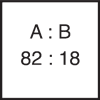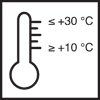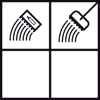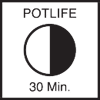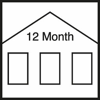Article No. 625113
Pigmented, self-levelling coating
Product specifications
Component A
Component B
Mixture
Once fully cured
* Epoxy resin mortar 1 : 10 with standard sand
The stated values represent typical product characteristics and are not to be construed as binding product specifications.
Field of application
- Coating
- Filled coating
Properties
- With static crack-bridging ability
- Can be subjected to mechanical loads
- Can be subjected to chemical loads
- Suitable for hand pallet trucks and forklift trucks
- Physiologically harmless once fully cured
-
Preparation
-
Substrate requirements
The substrate must be firm, dimensionally stable, capable of bearing loads and free of loose constituents, dust, oil, grease, rubber marks and other substances that could interfere with adhesion.
The adhesive pull strength of the surface after priming must be at least 1.5 N/mm² on average (smallest single value min. 1.0 N/mm²), compressive strength at least 25 N/mm².
A suitable Remmers epoxy primer or epoxy scratch coat must always be used.
-
Preparations
Depending on the substrate, prime with a suitable Remmers epoxy primer and, if needed, level with a - Remmers epoxy scratch coat.
Refer to the current Technical Data Sheet for detailed information on the single products.
-
-
Preparation
-
Combination container
Add the entire quantity of the hardener (component B) to the base compound (component A).
Mix thoroughly with a slow-speed electric mixer
(approx. 300 - 400 rpm).Pour the mixture into a separate container and mix again thoroughly.
Mix for at least 3 minutes.
Insufficient mixing is indicated by streaks forming.
-
Application
-
Application requirements
Temperature of material, surroundings and substrate: min. +10 °C to max. +30 °C.
-
Temperature Foot traffic after +8 °C 55 hours +12 °C 40 hours +20 °C 16 hours Setting may be accelerated by adding ACC H. The associated directions for use are available upon request.
As a general principle, higher temperatures will reduce and lower temperatures will increase the times stated.
-
Working tools / cleaning
-
Toothed trowel, toothed squeegee, smoothing trowel, looped roller, spiked roller, suitable mixing equipment
-
More detailed information can be found in the Remmers Tool Programme.
Clean tools, equipment and splashed material immediately while fresh with V 101.
Take suitable protective and waste disposal measures when cleaning.
-
Storage / shelf life
-
If stored unopened in the original container and kept cool, dry and protected from frost, min. 12 months (component A)/min. 24 months (component B).
-
Usage
-
See application examples
-
-
Application examples
-
Application Degree of filling with Selectmix 01/03 Appl. rate binder [kg/m²] Appl. rate mixture [kg/m²] Possible toothed blade Appl. rate per mm of layer thickness [kg/m²] Coating
< 1 mmno filling 0.8 - 1.0 0.8 - 1.0 No. 5 Coating
approx. 1 mmno filling 1.4 - 1.6 1.4 - 1.6 No. 7 1.50 Filled coating 1 : 0.3 min. 1.2 min. 1.5 No. 25 1.60 Filled coating 1 : 0.5 min. 1.5 min. 2.3 No. 46 1.65 Filled coating 1 : 0.8 min. 1.7 min. 3.0 No. 55 1.75 Filled coating 1 : 1 min. 1.8 min. 3.6 No. 72 1.80 -
Coating
Pour the material onto the prepared substrate and then distribute using a suitable tool, e.g. a notched trowel or notched scraper.
Subsequently roll over with a looped or a spiked roller.
The application rate depends on the substrate, temperature, required coating thickness, and optical requirements.
(see table)
-
Filled coating
Pour the material filled with Selectmix 01/03 on the previously prepared surface and distribute with a suitable toothed trowel/spreader and, if needed, roll over with a spiked roller.
The degree of filling must be chosen depending on substrate, temperature and required layer thickness.
(see table)
-
-
General information
-
Unless otherwise specified, all of the values and application rates given above have been determined under laboratory conditions (20 °C) using standard colours. Slight deviations from these values may arise if the product is worked with on site.
From experience, slightly opaque colours (e.g. yellow, red or orange, etc.) have a varnishing effect. Please consider this when choosing and assembling systems.
When coating continuous surfaces, only use materials with the same batch number as slight differences in colour, gloss and texture may occur.
Special colours, low layer thickness or differing sand fractions as well as lower temperatures can reduce the maximum degree of filling of the material and possibly affect the visual appearance of the surface.
In case of repairs on the surface or working up to existing surfaces, there will be a visible transition in appearance and texture.
Abrasive mechanical loads leave traces of wear.
Exposure to vehicles with metal or polyamide tyres as well as dynamic concentrated loads can cause faster wearing of the coating.
Epoxy resins are generally not colourfast when exposed to UV light or weather.
Further notes on working, system construction and maintenance of the listed products can be found in the latest Technical Data Sheets and the Remmers system recommendations.
-
-
Disposal instructions
-
Larger quantities of leftover product should be disposed of in the original containers in accordance with the applicable regulations. Completely empty, clean containers should be recycled. Do not dispose of together with household waste. Do not allow to enter the sewage system. Do not empty into drains.
-
-
Safety / regulations
-
For professional users only!
For further information on the safety aspects of transporting, storing and handling the product and on disposal and environmental matters, please see the current Safety Data Sheet and the brochure entitled "Epoxy Resins in the Construction Industry and the Environment", issued by Deutsche Bauchemie e.V. (3rd edition 2022).
-



